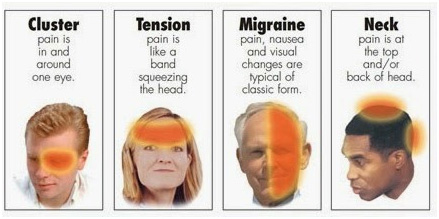In the beginning, spots or lines or colored lights may dance before your eyes. Soon a whole plethora of symptoms may ensue: redness, swelling, tearing, muscle contraction, hallucinations, irritability, depression, numbness, constipation or diarrhea and sometimes even a feeling of well-being! This is your warning.
Then the pain hits! It can range from minor discomfort to immobilizing agony and can last from minutes to days. The pain most likely occurs on only one side of the head along with nausea and vomiting.
This is the classic migraine that affects millions of people, including children.1 The majority of sufferers are women.2
NOT A TENSION HEADACHE
The migraine is different from the more common tension headaches. Migraines usually involve one side of the head, come on suddenly and only include nausea and vomiting if they are very severe.
THE CLUSTER HEADACHE
Cluster headache attacks come on abruptly, with intense throbbing pain arising high in one nostril and spreading behind the eye on that side of the face. The attacks tend to occur from once to several times daily in clusters lasting weeks or even months. Without apparent reason the cluster subsides as quickly as it began. Men between 20 and 40 are most affected by them.
TREATMENT
The treatment for a headache depends, of course, on what has presumably caused it. A headache arising from visual problems can often be cured by eyeglasses. An infection headache of the sinuses or ears is relieved when the infection subsides. But the most common headaches are usually treated with painkillers. This does not get to the cause of the problem but addresses only the symptoms. Of course, to someone experiencing intense pain, symptom relief is no small thing. However, the hundreds of millions of dollars spent each year on everything from aspirin and aspirin substitutes to codeine and prescription drugs may provide relief from headaches but don’t correct the cause or prevent recurrence.
For over a century chiropractic’s natural, drug-free approach to health has been a blessing to migraine and cluster headache sufferers. Chiropractors are the only healthcare professionals trained to analyze and correct subluxations which are tiny distortions in your spine and structural system that affect your nerves, joints, discs and internal organs, including your brain. This common condition can weaken your body, cause fatigue and pain, lower vitality and set the stage for sickness and disease.
By correcting subluxations your body can better restore itself to a greater level of health and wholeness—to better heal itself.
THE CHIROPRACTIC CHECKUP
Using his or her hands, X-ray, scales and other instruments, your chiropractor will determine if you have subluxations in your body. If you have them then he/she will give you a chiropractic adjustment or correction to remove them which will improve your body function and promote your natural healing ability.
THE SPINE/HEADACHE RELATIONSHIP
Research reveals migraine sufferers have abnormal nerve firings in the brain and spinal cord.3 This may be why chiropractic helps so many migraine sufferers and it dovetails with prior findings that headaches can be caused by structural distortions. A study of 6,000 people who suffered from recurring headaches for two to 25 years showed that spine injury was the most important factor in the cause of the headache and should be suspected in every case of recurring headache.4-5
CHIROPRACTIC & MIGRAINES
 There are many studies showing the benefits of the drug-free, natural healing approach of chiropractic for migraine sufferers.6-9
There are many studies showing the benefits of the drug-free, natural healing approach of chiropractic for migraine sufferers.6-9
For example, in one study chiropractic care resulted in a reduction of 90% of migraine episodes with the length of each migraine reduced by 38%. In addition, medication use dropped 94% and other symptoms associated with migraine such as nausea, vomiting, photophobia and phonophobia (light and sound sensitivity) were reduced.10
In a six-month study, half of 127 migraine sufferers were given chiropractic care while the other half were not. Twenty-two percent of the chiropractic group reported more than 90% reduction in migraines after two months and about 50% in the group reported significant decline in severity of migraines.11
In one study a 28-year-old woman with severe migraine headaches since she was a teenager as well as irregular menstrual cycles and inability to conceive began chiropractic care. Two months later she reported no headaches. A regular menstrual cycle began seven weeks into care and within six months she became pregnant.12
One ten-year-old girl with chronic, severe migraine (six times a week for the past three years) was under treatment by a neurologist at a children’s hospital. She was unable to go to school. Chiropractic examination revealed upper neck subluxations. After five adjustments she was back in school and leading a normal and healthy life.13
Anyone suffering from headache of any type would do well to see their chiropractor to ensure that they are free of subluxations. If there are subluxations in the body, no amount of drugs will correct them—a chiropractic adjustment is essential.
To schedule an appointment at Performance Chiropractic, please call us at (661) 942-5000.
References:
- Pakalnis A. New avenues in treatment of paediatric migraine: a review of the literature. Fam Prac. 2001;18(1):101-106.
2. Stewart WF, Lipton RB, Celentano DD, Reed ML. Prevalence of migraine headache in the United States. JAMA. 1992;267:64-69.
3. Neergaard L. Migraines are unique brain disorder. Associated Press. June 12, 2000.
4. Braaf MM, Rosner SJ. Trauma of the cervical spine as cause of chronic headache. Trauma. 1975;15:441-446.
5. Margulies S. The postconcussion syndrome after mild head trauma, part II:
is migraine underdiagnosed? J Clin Neurosci. 2000;7(6):495-499.
6. Ressel O, Rudy R. Vertebral subluxation correlated with somatic, visceral and immune complaints; an analysis of 650 children under chiropractic care. JVSR. October 18, 2004;1-23.
7. Simpson J, Hawken E. Xiphodynia: A diagnositc conundrum. Chiropractic & Osteopathy. 2007;15:13.
8. Bogduk N. The anatomical basis for cervicogenic headache. JMPT. 1992;15(1):67-70..
9. Kreeft J. Headache following whiplash. In Spine: State of the art reviews: Cervical Flexion-Extension/Whiplash Injuries. Sept 1993:395.
10. Tuchin PJ. A case series of migraine changes following a manipulative therapy trial. Australasian Chiropractic & Osteopathy. 1997;66(3):85-91.
11. Tuchin PJ, Pollard H, Bonello R. A randomized controlled trial of chiropractic spinal manipulative therapy for migraine. JMPT. 2000;23(2):91-95.
12. Vilan R. The role of chiropractic care in the resolution of migraine headaches and infertility. Journal of Clinical Chiropractic Pediatrics. 2004;6(1):338-341.
13. Bofshever H. Encephalgia/migraine. ICPA Newsletter. Jan/Feb 2000.
There are many studies showing the benefits of the drug-free, natural healing approach of chiropractic for


